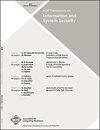使用自适应阈值调优的自动异常检测器自适应
Q Engineering
ACM Transactions on Information and System Security
Pub Date : 2013-04-01
DOI:10.1145/2445566.2445569
引用次数: 26
摘要
基于实时网络和主机的异常检测系统(ads)将连续的输入数据流转换为有意义和可量化的异常评分。随后将这些分数与固定的检测阈值进行比较,并将其分类为良性或恶意。我们认为实时ADS的输入随时间变化很大,固定的阈值不能保证这种时变输入的良好异常检测精度。在本文中,我们提出了一种简单而通用的技术来自适应地调整任何使用阈值方法的ADS的检测阈值。为此,我们首先对基于网络和主机的ads的异常评分进行统计和信息论分析,以揭示良性活动期间一致的时间相关结构。我们使用马尔可夫链对观察到的相关结构进行建模,然后将其用于随机目标跟踪框架中,以根据实时测量调整ADS的检测阈值。我们还使用统计技术使所提出的算法对零星变化和逃避攻击具有弹性。为了评估所提出的方法,我们将所提出的自适应阈值模块整合到多个ads中,并在全面且独立收集的网络和主机攻击数据集上评估这些ads。我们表明,在减少人工阈值配置的同时,所提出的技术为所有评估的ads提供了可观且一致的准确性改进。本文章由计算机程序翻译,如有差异,请以英文原文为准。
Automated Anomaly Detector Adaptation using Adaptive Threshold Tuning
Real-time network- and host-based Anomaly Detection Systems (ADSs) transform a continuous stream of input data into meaningful and quantifiable anomaly scores. These scores are subsequently compared to a fixed detection threshold and classified as either benign or malicious. We argue that a real-time ADS’ input changes considerably over time and a fixed threshold value cannot guarantee good anomaly detection accuracy for such a time-varying input. In this article, we propose a simple and generic technique to adaptively tune the detection threshold of any ADS that works on threshold method. To this end, we first perform statistical and information-theoretic analysis of network- and host-based ADSs’ anomaly scores to reveal a consistent time correlation structure during benign activity periods. We model the observed correlation structure using Markov chains, which are in turn used in a stochastic target tracking framework to adapt an ADS’ detection threshold in accordance with real-time measurements. We also use statistical techniques to make the proposed algorithm resilient to sporadic changes and evasion attacks. In order to evaluate the proposed approach, we incorporate the proposed adaptive thresholding module into multiple ADSs and evaluate those ADSs over comprehensive and independently collected network and host attack datasets. We show that, while reducing the need of human threshold configuration, the proposed technique provides considerable and consistent accuracy improvements for all evaluated ADSs.
求助全文
通过发布文献求助,成功后即可免费获取论文全文。
去求助
来源期刊

ACM Transactions on Information and System Security
工程技术-计算机:信息系统
CiteScore
4.50
自引率
0.00%
发文量
0
审稿时长
3.3 months
期刊介绍:
ISSEC is a scholarly, scientific journal that publishes original research papers in all areas of information and system security, including technologies, systems, applications, and policies.
 求助内容:
求助内容: 应助结果提醒方式:
应助结果提醒方式:


